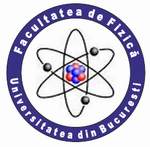| |
 |
UNIVERSITY OF BUCHAREST
FACULTY OF PHYSICS Guest
2025-10-05 22:21 |
 |
|
|
|
Conference: Bucharest University Faculty of Physics 2025 Meeting
Section: Theoretical and Computational Physics, High-Energy Physics, Applied Mathematics
Title:
Laser-driven proton acceleration with multi-PW laser pulses and double-layer targets by 3D PIC simulations
Authors:
Vojtěch Horný, Domenico Doria
Affiliation:
Extreme Light Infrastructure - Nuclear Physics, IFIN-HH, 30 Reactorului Street, 077125 Magurele, Romania
E-mail
vojtech.horny@eli-np.ro
Keywords:
laser plasma, ion acceleration, particle-in-cell, numerical simulation, double-layer target
Abstract:
The progress made in compact laser-based ion accelerators over the past two decades [1] has opened up promising perspectives across various research and application areas [2-4]. Nowadays, laser systems can deliver ≃25 fs pulses as powerful as 10 PW, enabling reaching a peak pulse intensity of the order of 10^22 W cm-2 and even higher. Nevertheless, despite such a tremendous increase in the intensity of generated laser pulses, the actual highest proton peak energy measured (up to 160 MeV [5]) remains behind expectation, mainly due to limitations related to the laser temporal profile.
We suggest a regime where the protons can be accelerated to energies up to many 100s MeV. The scheme is based on a single intense laser pulse penetrating through a double-layer target. The front side of the target is made of homogeneous near-critical density carbon, where the various laser prepulses are mitigated and the relativistic self-focusing effect intensifies the main laser pulse. Indeed, if designed properly, the laser pulse becomes highly self-focused and its intensity might increase several times for the cost of sacrificing part of its energy [6]. Such a lensing layer is attached to a solid layer which serves as an acceleration medium. The standard target normal sheath acceleration (TNSA) process is enhanced by mechanisms of the front surface acceleration (FSA) and light-sail radiation pressure acceleration (LS-RPA), as the high intensity pulse first drives efficiently the shock within the solid layer, and eventually penetrates through the target at the latter stage of the interaction characterized by the relativistically induced transparency (RIT). The thicknesses of the target layers are designed in such a way that both the laser intensification and proton acceleration are optimized. The research is conducted exploiting full 3D PIC simulations. Their technical details are discussed and the influences of various numerical parameters are evaluated.
References:
[1] A. Macchi, M. Borghesi, and M. Passoni, Reviews of Modern Physics 85, 751 (2013).
[2] D. B. Schaeffer et al., Reviews of Modern Physics 95, 045007 (2023).
[3] S. Malko et al., Nature Communications 13, 2893 (2022).
[4] F. Kroll et al., Nature Physics 18, 316 (2022).
[5] T. Ziegler, et al., Nature Physics, 2024, 1-6.
[6] A. Pazzaglia et al., Communications Physics 3, 133 (2020).
Acknowledgement:
Extreme Light Infrastructure Nuclear Physics (ELI-NP) team acknowledges the support of the Romanian Government and the European Union through the European Regional Development Fund - the Competitiveness Operational Programme (1/07.07.2016, COP, ID 1334) Phases II, and the Romanian Ministry of Research, Innovation and Digitalization: Program Nucleu PN23210105. Accessing the ELI-NP facility is supported by the IOSIN funds for research infrastructures of national interest funded by the Romanian Ministry of Research, Innovation and Digitalization. Authors draw support also from the ELI-RO contracts ELI-RO/RDI/2024\_14 SPARC and ELI-RO/RDI/2024\_2024\_008 AMAP funded by PN III/P5/Subprogram 5.1. We acknowledge EuroHPC Joint Undertaking for awarding us access to Karolina at IT4Innovations (VŠB-TU), Czechia under project number EHPC-REG-2023R02-006 (DD-23-157); Ministry of Education, Youth and Sports of the Czech Republic through the e-INFRA CZ (ID:90140).
|
|
|
|

